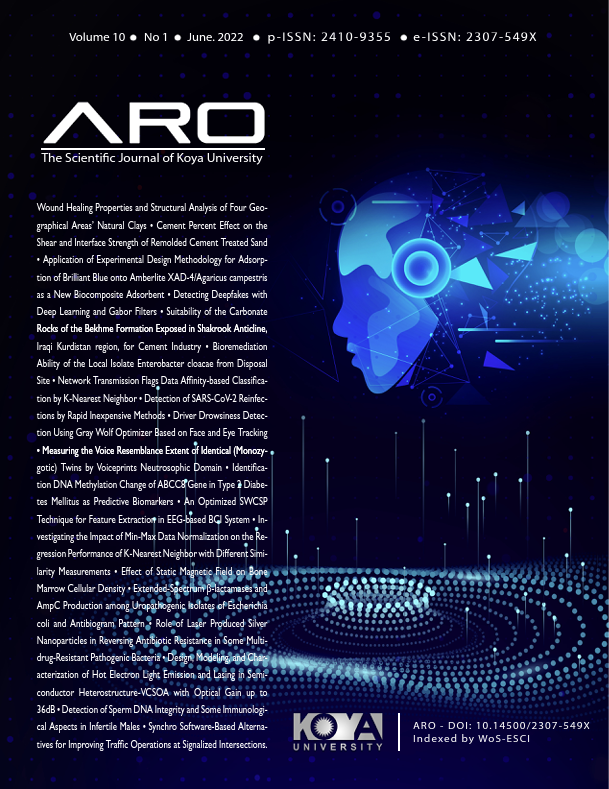Synchro Software-Based Alternatives for Improving Traffic Operations at Signalized Intersections
DOI:
https://doi.org/10.14500/aro.10915Keywords:
Level of service, Optimization, Signalized intersections, Synchro softwareAbstract
Traffic congestion is a considerable problem in urban arterials, especially at signalized intersections. Signalized intersections are critical elements of the highway system, thus improving their performance would significantly influence the overall operating performance of the system in terms of delay and level of service (LOS). The aim of this study is to assess the capacity performance of two signalized intersections in Duhok city, namely, Zari land intersection and Salahaddin Mosque intersection using the procedure in the Highway Capacity Manual and Synchro software. Total intersection delay, LOS, and volume to capacity ratio (v/c) were the measures of effectiveness used for comparison purposes. Different optimization alternatives have been tested to improve current and future performance. The results have shown that the Zari land intersection is currently operating at LOS F with an average delay of 590 s/veh and high values of v/c at specific movements. Results of optimization show that the scenario of creating an overpass with a change in cycle length and adding one additional lane in each direction is the best alternative to improve its performance to the LOS D with the maximum v/c ratio of 0.86. For Salahaddin Mosque intersection, the delay can be reduced from 544 s/veh (LOS F) with high values of v/c at the major street through movement to an average delay of 70 s/veh (LOS E) and maximum v/c ratio of 1, when cycle length and geometrics are changed, and approaching traffic from the minor street is prohibited.
Downloads
References
Al-Allaff, R.A., Jrew, B., Abojaradeh, M. and Msallam, M., 2015. Evaluation and Improvement of Traffic Flow and Traffic Network Management System in Al-Shmesani Amman Jordan. 7th Traffic Safety Conference from 12-13 May 2015 in Amman, Jordan.
Chen, P., Qi, H. and Sun, J., 2014. Investigation of saturation flow on shared right-turn lane at signalized intersections, Transportation Research Record: Journal of the Transportation Research Board, 2461, pp.66-75.
HCM, 2010. Highway Capacity Manual, Transportation Research Board, National Research Council. USA, Washington, DC. He, S., Wang, W., Zhang, J. and Yang, J., 2013. An improved optimization method for isolated signalized intersection based on the temporal and spatial resources integration. Procedia Social and Behavioral Sciences, 96, pp.1696-1706.
Joni, H.H. and Hikmatt, M.M., 2017. Assessment at Al-Ameer signalized intersection in Samawa city. In: Third International Conference on Building, Construction and Environmental Engineering, Egypt.
Jrew, B.K. and Abojarade, M.A., 2009. Evaluation and Improvement of Wadi-Saqra Signalized Intersection in Amman City. The 4th Conference in Scientific Research in Jordan, Jordan Society for Scientific Research, 7 November 2009, Amman Jordan. Highway and Traffic in Jordan, pp.3-19.
Koonce, P., Rodegerdts, L., Lee, K., Quayle, S., Beaird, S., Braud, C., Bonneson, J., Tarnoff, P. and Urbanik, T., 2008. Traffic Signal Timing Manual. USDOT-FHWA, Project HOP-08-024, USA, Washington DC.
Nyantakyi, E.K., Adams, C.A., Borkloe, J.K. and Pobee, D., 2013. Synchronization of signalised intersections: A case study of three major intersections on the 24th February road, Kumasi, Ghana. International Journal of Engineering Research and Applications, 3(4), pp.2566-2590.
Park, B., Messer, C.J. and Urbanik, T., 1999. Traffic signal optimization program for oversaturated conditions genetic algorithm approach. Transportation Research Record, 1683, pp.133-142.
Potts, I.B., Ringert, J.F., Bauer, K.M., Zegeer, J.D., Harwood, D.W. and Gilmore, D.K., 2007. Relationship of lane width to saturation flow rate on urban and suburban signalized intersection approaches, transportation research record. Journal of the Transportation Research Board, 2007, pp.45-51.
Ragab, M. and Abo El-Naga, I., 2019. Measures to improve traffic operations at signalized intersection in urban areas. International Journal for Traffic and Transport Engineering, 9(4), pp.408-418.
Ratrout, N. and Assi, K., 2019. Development and evaluation of a quick method for optimizing a space and timing plan for isolated signalized intersection. Transport, 36(2), pp.1-12.
Roy, C.K., Barua, S. and Das, A., 2015. A Study on Feasible Traffic Operation Alternatives at Signalized Intersection in Dhaka City. In: International Conference on Recent Innovation in Civil Engineering for Sustainable Development (IICSD-2015), DUET Gazipur, Bangladesh.
Sabra, Z., Wallace, C.H.E. and Lin, F., 2000. Traffic Analysis Software Tools. Transportation Research Board (TRB)/National Research Council, Transportation Research Circular E-C014.
Siddiqui, S., 2015. Signal Timing Evaluation and Optimization. Technical Report. SPSS, 2021. Statistical Package for the Social Sciences, Version 27, 2021.
Sunkari, S., 2004. The benefits of retiming traffic signals. ITE Journal, 74(4), pp.26-29.
Synchro, 2011. Synchro Studio 8 User Guide. Udomsilp, K., Arayakarnkul, T., Watarakitpaisarn, S., Komolkiti, P., Rudjanakanoknad, J. and Aswakul, C., 2017. Traffic data analysis on sathorn road with synchro optimization and traffic simulation. Engineering Journal, 21(6), pp.57-67.
Zhang, Y., Sun, D.J. and Kondyli, A., 2017. An empirical framework for intersection optimization based on uniform design. Journal of Advanced Transportation, 2017(4), pp.1-10.
Ziboon, A.T., Qasim, Z.I. and Yousif, M.A., 2019. Traffic performance evaluzation and aanalysis of Al-Fallah intersection in Baghdad City utilizing synchro.10 software. Journal of Engineering and Sustainable Development, 23(6), pp.25-34.
Downloads
Published
How to Cite
Issue
Section
License
Authors who choose to publish their work with Aro agree to the following terms:
-
Authors retain the copyright to their work and grant the journal the right of first publication. The work is simultaneously licensed under a Creative Commons Attribution License [CC BY-NC-SA 4.0]. This license allows others to share the work with an acknowledgement of the work's authorship and initial publication in this journal.
-
Authors have the freedom to enter into separate agreements for the non-exclusive distribution of the journal's published version of the work. This includes options such as posting it to an institutional repository or publishing it in a book, as long as proper acknowledgement is given to its initial publication in this journal.
-
Authors are encouraged to share and post their work online, including in institutional repositories or on their personal websites, both prior to and during the submission process. This practice can lead to productive exchanges and increase the visibility and citation of the published work.
By agreeing to these terms, authors acknowledge the importance of open access and the benefits it brings to the scholarly community.
Accepted 2022-06-27
Published 2022-06-30
















 ARO Journal is a scientific, peer-reviewed, periodical, and diamond OAJ that has no APC or ASC.
ARO Journal is a scientific, peer-reviewed, periodical, and diamond OAJ that has no APC or ASC.